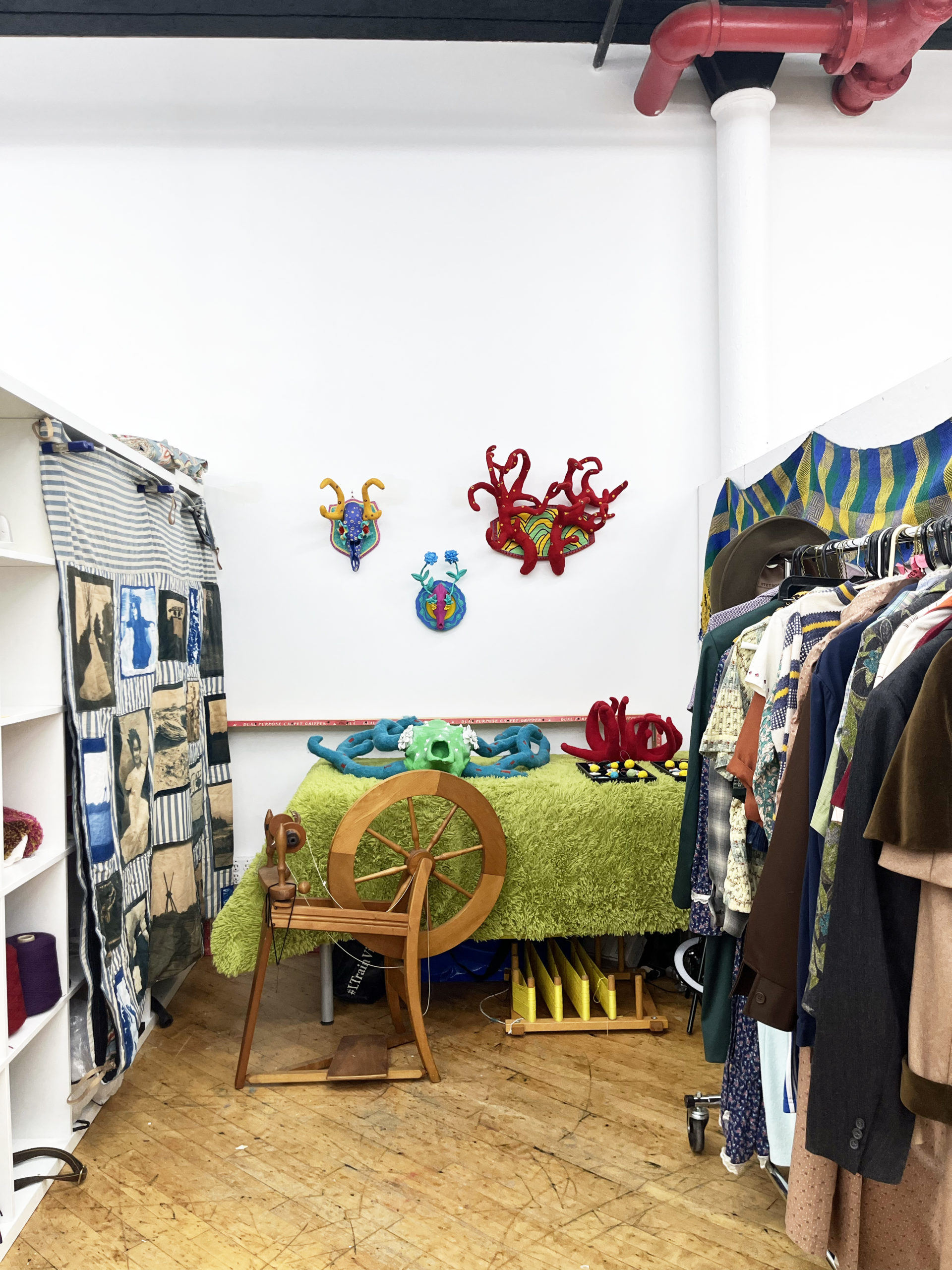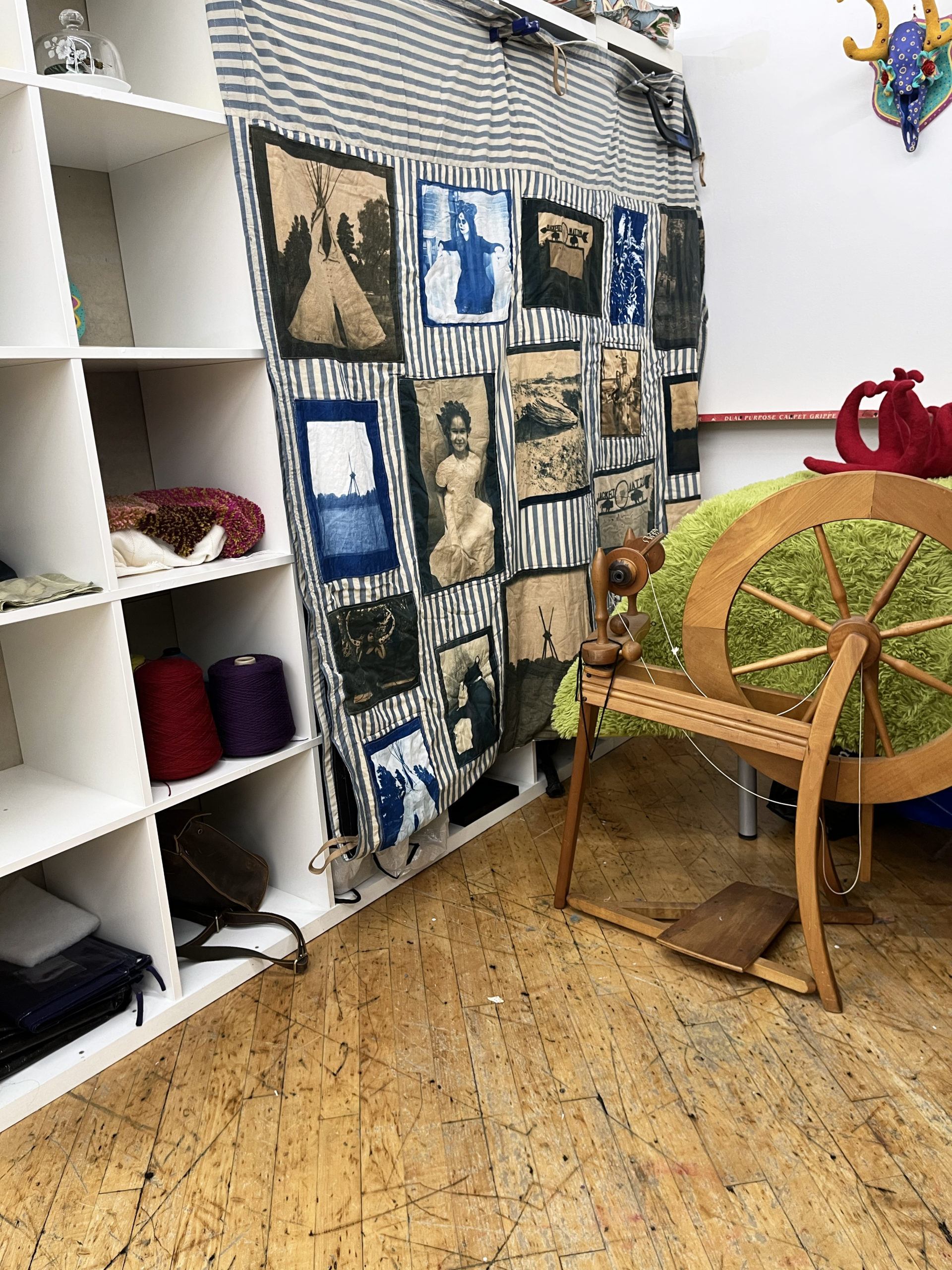The Colorful World-Building of Mary Evangeline Guadalupe Rubi
“Home” comes to mind at the sight of artist Mary Evangeline Guadalupe Rubi’s studio at the Textile Arts Center. The walls feature colorful characters created by Rubi, the shelves are packed with a mod podge of hard working and simple tools, small taxidermied butterflies, while an oversized quilt hangs invitingly beside the artist’s workspace. Prior to becoming a visual artist, Rubi graduated college with a literature and history degree with the intention of becoming a writer. Rubi’s interest in writing comes from a passion for world-building, which she later realized could be explored in physical forms such as costume and visual art. Currently, Rubi manages a costume shop and works as a wardrobe technician for various New York theater companies. Rubi loves creating workspaces that invoke the feeling of home, wherever this may be. She phrases this thought specifically as entering a room and thinking, “how can I make home anywhere?” The space is inviting and she urges her audience to feel welcome in both her art space and making process. Prior to sitting down with Rubi to complete this feature, a visiting mother and daughter duo passed by her studio and Rubi welcomed the young girl to learn how to hand felt using the project that she was currently working on; this moment in time very much characterizes both Rubi’s warm personality and her joy bringing artwork.

At first glance, the art of Mary Rubi is colorful and flashy in ways that entice the viewer to take a closer look. Stepping closer reveals unimaginable materials: animal bone and incredibly detailed hand felting that contribute to an overall tone of joy and home building. Taxidermy is a surprising feature of Rubi’s art because it is not initially visible at first glance due to the choice of memorable and bold color work. “The audience does not need to know that there is real bone,” Rubi explained. Rather, the hidden taxidermy is an honor of what the artist calls the “life, death, life” cycle as she reinvigorates the lives of these animal bones and renews them in her work. The bones used are not always from the same animals as the artist often reassembles the pieces into a new animal-esque shape. These pieces are inspired by Indigenous folklore, Rubi’s own dual Metis and Latin background, and Rubi’s interest in world-building narratives. The color work and natural imagery of both Georgia O’Keeffe and T.C. Cannon also influenced the bright imagery that Rubi portrays through soft sculpture. Red is a common color in Rubi’s toolkit, which comes from the Indigenous belief that red is the only color that spirits can see. In Rubi’s Queens Botanical Gardens exhibit, “Spirit Sees Red” the artist featured a piece where the eyes of the taxidermied coyote stood out in bright red so that they could interact with the spirit world. Though red eyes are no longer a prominent feature of Rubi’s work, the use of red still demands attention throughout her body of work. When asked about the possibility of the audience misunderstanding her art and use of taxidermy, Rubi replied that the audience is encouraged to be able to make their own connections and interpretations of what they are viewing in her art. This is why knowing there is real bone present is not necessarily a key point that influences connection with Rubi’s art. The work is meant to engage everyone, regardless of their background or what they come into the gallery knowing about the artist.
Featured alongside the bone material in Rubi’s current work is both resin clay and wool felt. Rubi takes pride in the accessibility of key materials in her practice as they are materials that can be worked with easily in closed and intimate spaces. Without access to a kiln, Rubi uses air drying clay, which she can mold for longer periods of time in her own home and uses wood pulp to cover the parts of the clay that she felts over using a hand held felter. It can take weeks to complete large projects that need to be completely covered in felt, but Rubi views this time as part of her art making process because she works intuitively rather than primarily through intense research. When asked about how she knows when a piece is “done” Rubi explained that though pieces may feel finished at one point, she gives herself the chance to always return to them in the future. The process of adding onto older art is her “play period” where she can test new methods to work with in future projects. Along with Rubi’s costume design work, the artist has experience teaching at the Roundabout Theatre; Rubi’s aim in teaching is to help budding artists find well paying careers in the arts that do not take advantage of their eagerness to learn. Teaching has found its way into the way Rubi makes art as accessibility has come to the forefront of Rubi’s process. Through the use of accessible materials and the encouragement for the audience to create their own relationships with the art she makes, Rubi aims to make the art process less daunting and more accessible to the average person with little to no background in art. In other words, people are capable of and encouraged to feel connected to art even if they have no history of art making themselves.
Next in store for Mary Rubi is a full ride to Georgia State University to acquire an MFA in sculpture, which she would have never predicted for herself in the past. Rubi hopes to expand her familiarity with different sculpture mediums and create even more “welcoming” art. The goal is to maintain the air of “intimate work for the home” even through Rubi’s exploration of other art materials. As an artist in residence at the Textile Arts Center, Rubi has felt a tight sense of community amongst the other residents and has gained a newfound interest in historical research, which has been helpful to her as an artist often led by intuition. Rubi feels that through the lectures presented at TAC, she has gained explanation for why she feels an intuitive connection to some of her craft and making process. Through the residency, Rubi explained that she has realized the magnitude of her gratitude towards her family and newfound community, especially considering how her father was not capable of pursuing a career as an artist because of financial obligation. Regardless of where Mary Rubi finds herself in the future, it is clear that she will continue to create art that invokes memorable sensations that bond the audience to the artist.
Follow Mary @m.e.guadalupe on instagram & Website: https://meguadalupedesigns.wpcomstaging.com/
